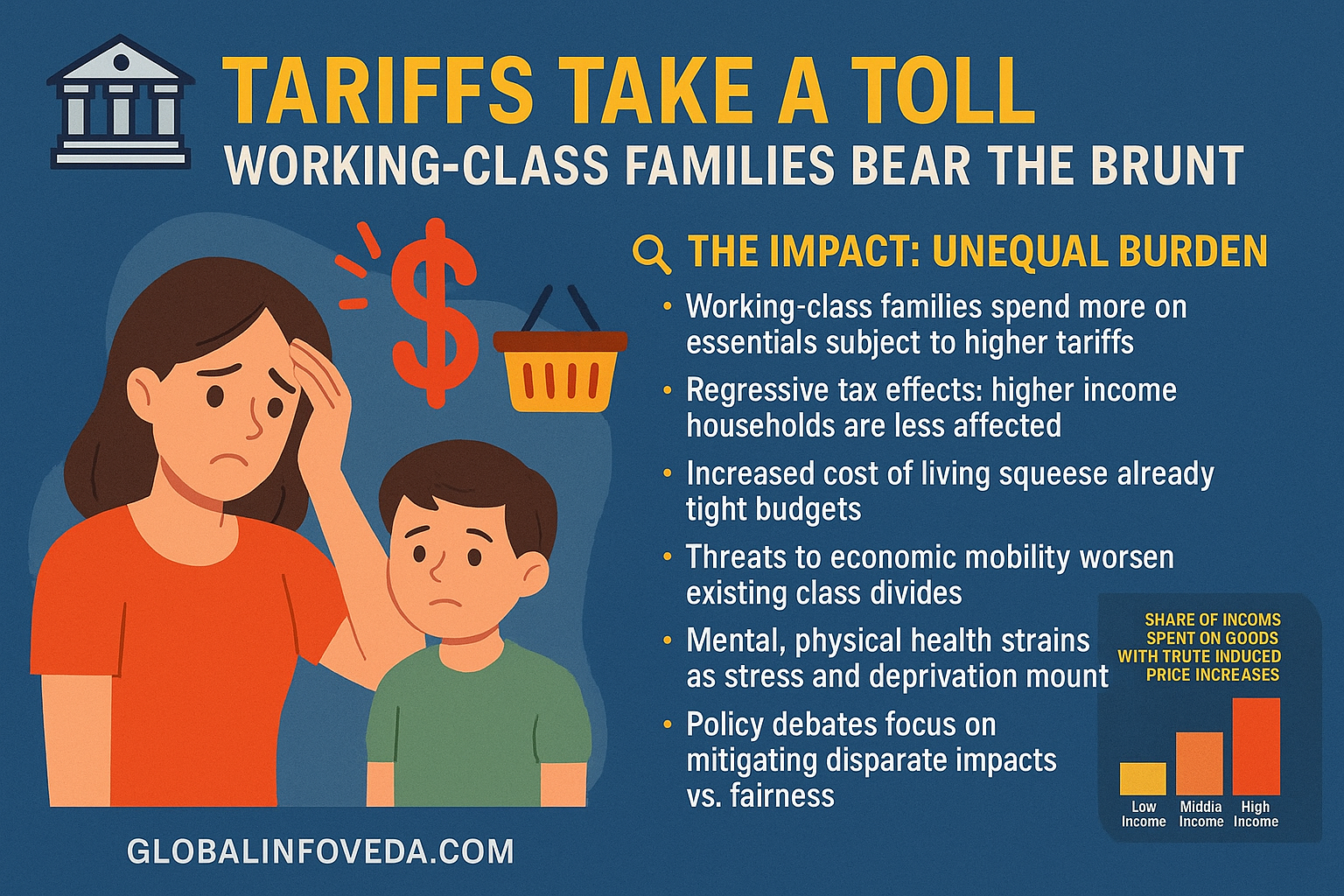Working-Class Families Hit Hardest by Tariff Anxiety
🏛️ Introduction: A Hidden Tax on the Vulnerable
Tariff hikes on imported goods in 2025 are rippling through the U.S. economy, but working-class families are feeling the sharpest pain. While the government frames these tariffs as a way to protect domestic jobs and manufacturing, the reality on the ground is that they push up prices for essentials—groceries, fuel, clothing, electronics, and household goods—acting as a regressive tax on those least able to absorb the hit.
This blog explores why the working class is disproportionately impacted, the sectors most affected, the coping strategies households are using, and the policy responses that could make a difference.
📊 Big Picture: Why Working Families Are More Exposed
- High Essential Spending: Over 70% of working-class income goes toward essentials, compared to ~45% for higher-income households.
- Limited Safety Nets: Less than 35% of households earning under $50,000 have even one month’s worth of emergency savings.
- Debt Vulnerability: Rising costs push many into credit card reliance, with interest rates making repayment harder.
- Sector Exposure: Retail, automotive repair, small-scale manufacturing, and agriculture—industries reliant on imports—are squeezed by higher input costs.
- Regional Pressure: Industrial Midwest and rural agricultural states feel sharper local economic downturns.
📌 In context: For a household earning $45,000 annually, an extra $250–$300 per month in living costs represents 6–8% of total income—a significant blow.
🔍 Sectoral Exposure: Who’s Most at Risk?
1. Groceries & Food Supply
- Tariffs on agricultural imports (wheat, soybeans, dairy) push up prices at the checkout.
- Food inflation disproportionately affects low-income families reliant on budget-friendly staples.
2. Energy & Utilities
- Imported equipment tariffs raise costs for energy providers.
- Utility bills climb, further tightening monthly budgets.
3. Retail & Consumer Goods
- Clothing, electronics, and household appliances face double-digit price increases.
- Small retailers lose customers to large chains that can negotiate better prices.
4. Transportation & Auto Repair
- Imported parts tariffs raise costs for repairs and maintenance.
- Car prices—both new and used—rise due to higher production costs.
💵 Economic Impact Analysis
- Household Budget Strain: Families cut back on healthcare, school activities, and home maintenance.
- Debt Dependency: More households rely on credit, leading to long-term financial instability.
- Community Slowdown: Reduced spending affects local small businesses and municipal revenues.
- Generational Impact: Lower investment in children’s education and extracurricular development.
📈 Historical Context
The 2018–2019 trade disputes provide important lessons:
- Price hikes of 15–20% for everyday goods like washing machines and electronics.
- Low-income households bore the brunt, while manufacturing gains were short-lived.
- Job losses in retail and export-reliant sectors offset any manufacturing job increases.
📊 Income-Based Tariff Impact Comparison
| Income Group | % of Income on Essentials | Impact Severity | Common Coping Strategies |
|---|---|---|---|
| Under $50,000 | 70%+ | Very High | Increased debt, lower food quality, bill delays |
| $50,000–$100,000 | 55–65% | High | Brand switching, delaying major purchases |
| Over $100,000 | 40–50% | Moderate | Reduced discretionary spending |
🏛️ Policy & Relief Measures: What Could Help?
1. Essential Goods Exemptions
- Remove tariffs on staple foods, medicines, and critical household goods.
2. Targeted Tax Credits
- Expand Earned Income Tax Credit (EITC) for low- and middle-income households.
3. Wage & Job Support
- Offer wage subsidies for workers in sectors hit hardest by import cost increases.
4. Small Business Aid
- Low-interest loans or grants to help SMEs adapt supply chains.
🔮 Final Insight: Cushioning the Blow
Tariffs may serve a strategic purpose, but without targeted relief, they deepen economic inequality. Working-class families are absorbing the double shock of higher prices and stagnant wages, with ripple effects that slow local economies. Policymakers must pair trade protection with real protections for households, or risk widening the gap between America’s economic winners and losers.
📡 Stay connected to GlobalInfoVeda.com for ongoing coverage of trade, policy, and household economics.
